Manufacturing—Forever on the Move
January 1, 2008Comments
In industry, so many factors determine what we make and where we make it. Since mankind first walked the earth, he was slave to his surroundings, and surroundings were slave to him. We’ve since learned to walk, run, ride, fly and communicate, tearing the anchor from our leg. Humans are mobile, active and agile, and so is industry. Metalforming in the Southeast, beginning on page 22 in this issue, describes just how mobile and agile manufacturing is.
Think about how the Midwest became a manufacturing hub more than a century ago. The Great Lakes attracted the people, who brought their skills and entrepreneurial intentions. It so happens that the Industrial Revolution and its aftermath paralleled the population migration; naturally, citizens employed and evolved the new technology, and found willing markets in their local—huge and growing—population bases.
Perfect examples are the steel and automobile industries. Both arose and grew in areas where transportation of raw materials and finished products was readily available, where customers hungry for their products lived, and where supplier bases could be formed. It is no accident that automotive plants set up in the shadows of the big steel mills, amidst a sea of humanity that served as a ready source of workers. Not to say certain seemingly minor events didn’t profoundly alter that landscape.
One such minor event revolved around one Alexander Winton. Around 1900, in Cleveland, as Richard Wright related in a Detroit News article, Winton began producing horseless carriages. He sold one of these to James Packard. On his 60-mile journey back to Warren, OH, Packard’s vehicle broke down, sending him back to Cleveland to give Winton some ideas on building a better machine. It seems Winton told Packard that if he wanted a better machine, he should build it himself. Packard did just that, and soon after set up shop in Detroit. Packard became one of the best-selling and best-known brand of its day, and the company continued to make cars until the mid-1950s. But Winton wasn’t content to chase one gifted carmaker out of town. Henry Ford had applied for a job at Winton and Alexander turned him down.
The rest is history: Detroit became the Motor City and Cleveland, with unfortunate help from Mr. Winton, could forever stew about what might have been.
There was no Wintonesque moment that saw manufacturing shift to the South, it was the traditional shift of people and markets—including the need to supply OEMs and other customers in Mexico. It’s easier to move around these days, and manufacturers, led by transplant OEMs looking to gain a foothold and build vehicles closer to their customers, moved in. Their Tier One suppliers followed as did others along the supply chain. Next thing you know, the South and Southeast have built efficient industrial bases. Of course, many other factors contributed to increased manufacturing in the Southeast, including land availability and energy- and labor-cost advantages. But by no means has the shift finished off manufacturing in its traditional regions, and it can even help add to the economic diversity and strength of our nation.
At the root, whether in Ohio, Michigan, Alabama or California, all metalformers have to deal with certain basics such as overseas competition, part and tool design, material cost and quality, productivity, and the inclusion of value-added. These basic challenges have als forced the industry to work smarter and more resourceful. None of that will change. What has changed, and what will continue to change, is how we serve our markets. That will determine where we set up shop—and how, and what, we produce. That means employing new technology and learning new, efficient s to do things. To survive, like our ancestors did, we’ll have to tear the anchor of old, tired s from our leg. MF
Technologies: Management
Comments
Must be logged in to post a comment. Sign in or Create an Account
There are no comments posted. Management
ManagementDOL Announces Nearly $200 Million Allotted for Registered Ap...
Friday, March 1, 2024
 Management
ManagementMetalForming LIVE 2024: Recruit, Retain, Train
Monday, January 22, 2024
 Webinar
Webinar 






 Podcast
Podcast